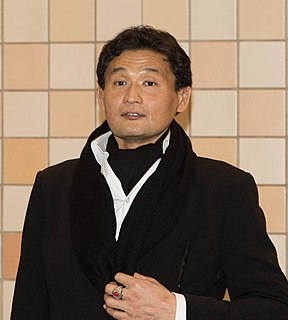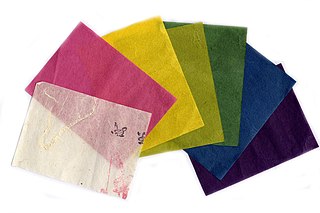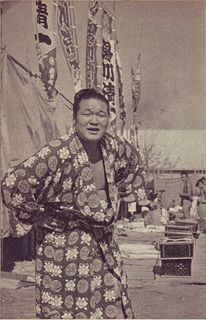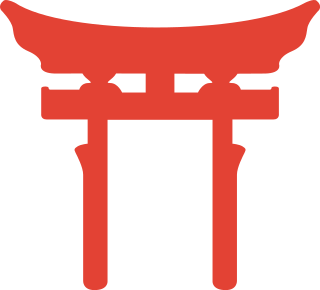
Takanohana (II) Kōji is a Japanese former sumo wrestler and coach. He was the 65th man in history to reach sumo's highest rank of yokozuna, and he won 22 tournament championships between 1992 and 2001, the sixth highest total ever. The son of a popular ōzeki ranked wrestler from the 1970s, Takanohana's rise through the ranks alongside his elder brother Wakanohana and his rivalry with the foreign born yokozuna Akebono saw interest in sumo and attendance at tournaments soar during the early 1990s.

Washi (和紙) is traditional Japanese paper. The word "washi" comes from wa meaning 'Japanese' and shi meaning 'paper'. The term is used to describe paper that uses local fiber, processed by hand and made in the traditional manner. Washi is made using fibers from the inner bark of the gampi tree, the mitsumata shrub, or the paper mulberry (kōzo) bush. As a Japanese craft, it is registered as a UNESCO intangible cultural heritage.
The Japan Sumo Association is the body that operates and controls professional sumo wrestling in Japan under the jurisdiction of the Japanese Ministry of Education, Culture, Sports, Science and Technology (MEXT). Rikishi, gyōji (referees), tokoyama (hairdressers), and yobidashi (ushers/handymen), are all on the Association's payroll, but the organisation is run entirely by toshiyori (elders). The organization has its headquarters in Yokoami, Sumida, Tokyo.

Kyokushūzan Noboru is a former professional sumo wrestler and current politician of the Democratic Party in Mongolia. He was the first wrestler from Mongolia to reach sumo's top makuuchi division.

Ushiomaru Motoyasu is a former sumo wrestler from Shizuoka, Japan. He began his professional career in 1994 and first reached the top division in 2002. His highest rank was maegashira 10. He retired in May 2009 to take over the Azumazeki stable.

The following words are terms used in sumo wrestling in Japan.

In Shinto, shintai, or go-shintai when the honorific prefix go- is used, are physical objects worshipped at or near Shinto shrines as repositories in which spirits or kami reside. Shintai used in Shrine Shinto can be also called mitamashiro.
Match-fixing in professional sumo is an allegation that has plagued professional sumo for decades. Due to the amount of money changing hands depending on rank, and prize money, there had been reports of yaochō (八百長) in professional sumo for years before it was finally definitively proven to exist in 2011. The hierarchical structure of the sport, in which a minority of top-ranked wrestlers have great advantages in salary, privileges and status over the lower-ranked wrestlers that make up the majority of sumo participants, may have contributed to the use of match-fixing in order to prolong careers for top-ranked wrestlers and assist in the distribution of promotions.

Kasugafuji Akihiro, born as Shoki Iwanaga, was a Japanese sumo wrestler and coach from Oshika, Miyagi. He was an active wrestler in professional sumo from 1981 until 1996, reaching a highest rank of maegashira 1. After his retirement he re-established the Kasugayama stable in 1997 and trained his own wrestlers. He left the Japan Sumo Association in 2012 after an expenses scandal, and was involved with a legal dispute in 2013 with his successor as head of Kasugayama stable which was not resolved until shortly before his death in 2017.
Amatsukaze Masao, born Masao Miyanaga, was a sumo wrestler from Monzen, Ishikawa, Japan. He made his professional debut in May 1955 and reached the top division in September 1962. His highest rank was maegashira 3. He left the sumo world upon retirement in May 1967.

Oiteyama Hirokuni, born Mitsugu Yamaguchi, was a sumo wrestler from Goshogawara, Aomori, Japan. He made his professional debut in May 1953 and reached the top division in May 1960. His highest rank was maegashira 6. Upon retirement from active competition he became an elder in the Japan Sumo Association. He reached the Sumo Association's mandatory retirement age of 65 in June 2003.
Katsuhikari Toshio was a Japanese sumo wrestler. He made his professional debut in November 1958 and reached the top division in September 1969. His highest rank was maegashira 1. Upon retirement from active competition he became an elder in the Japan Sumo Association under the name Wakafuji. He reached the Sumo Association's mandatory retirement age in August 2007. He died from cancer of the bile duct on 1 January 2018 aged 75.

Hinomaru Sumo is an ongoing Japanese sumo shōnen manga series written and illustrated by Kawada. It's published by Shueisha, with serialization in Weekly Shōnen Jump magazine since May 26, 2014 and with 24 volumes compiling the chapters released so far. A 24-episode anime television series adaptation by Gonzo has been announced, and aired from October 5, 2018 to March 29, 2019.

Shōdai Naoya is a sumo wrestler from Uto, Kumamoto, Japan. He is in the Tokitsukaze stable. He is a right hand inside-type wrestler. His highest rank is sekiwake. He has one gold star for defeating a yokozuna.
Nezumi no Sumō is a Japanese folk tale. It tells the story of an old man and his wife who help out some mice who engage in sumo. As a reward, one of the mice gives them enough gold on which to live for the rest of their lives.

Ōnoshō Fumiya is a professional sumo wrestler from Aomori Prefecture, Japan. He debuted in sumo wrestling in January 2013 and made his top makuuchi debut in May 2017. His highest rank has been komusubi, and he has won three special prizes for Fighting Spirit. He wrestles for Ōnomatsu stable.
The sumo cannabis scandal is a series of cannabis scandals in professional sumo since August 2008. Four sumo wrestlers classified as sekitori, the top two division, Wakanohō, Rohō, Hakurozan and Wakakirin, were dismissed from professional sumo, and Kitanoumi Toshimitsu resigned his post as the chairman of the Japan Sumo Association (JSA) to take the blame. It is the first case in which active wrestlers have been dismissed from sumo. After that, the JSA added rules that any retirement package for dismissed members would be reduced or denied, and that those who use illegal drugs would be dismissed without benefits. Many Japanese news and some English news, such as BBC News and the Daily Telegraph, reported it. According to the Japan Times, it was the largest sports scandal of drugs that Japan had ever seen.
Meisei Chikara (明生力), is a professional sumo wrestler. He debuted in sumo wrestling in July 2011 and made his makuuchi debut in July 2018. His highest rank has been maegashira 11. He wrestles for Tatsunami stable.















